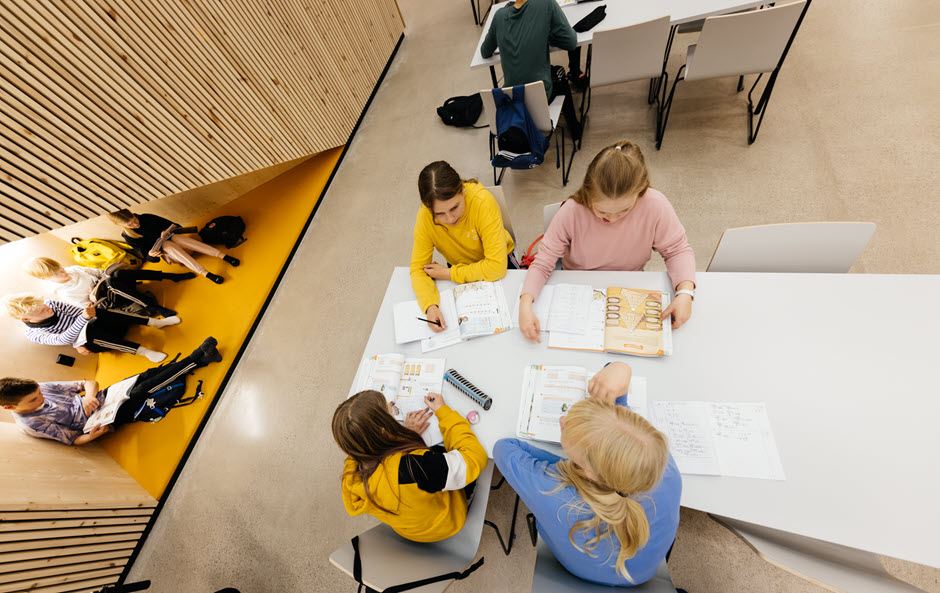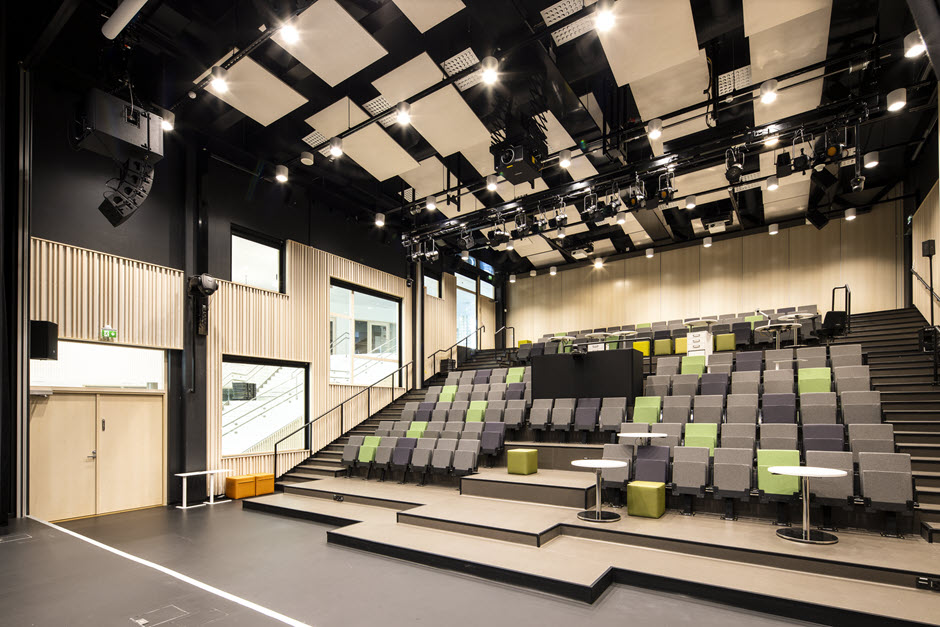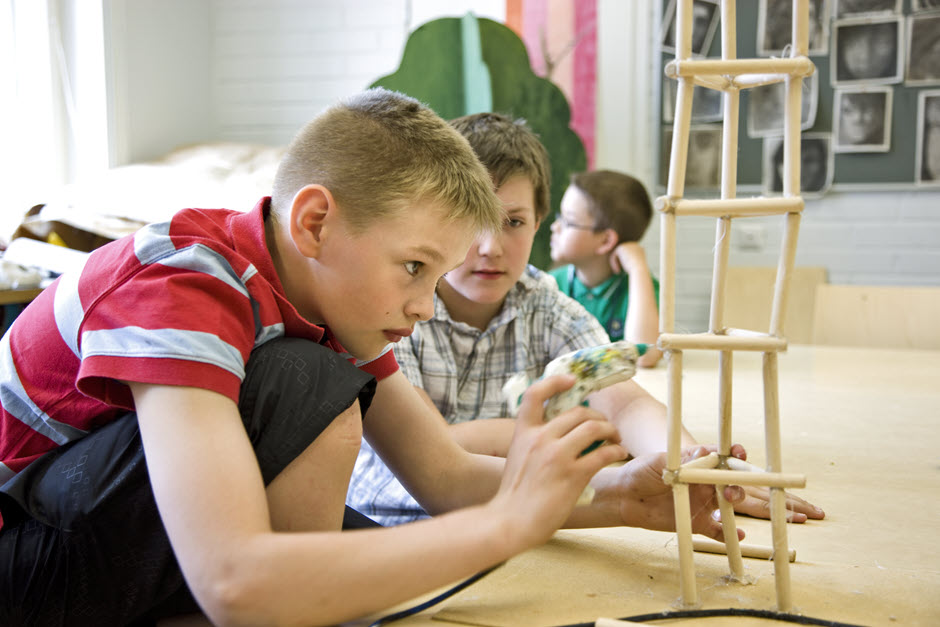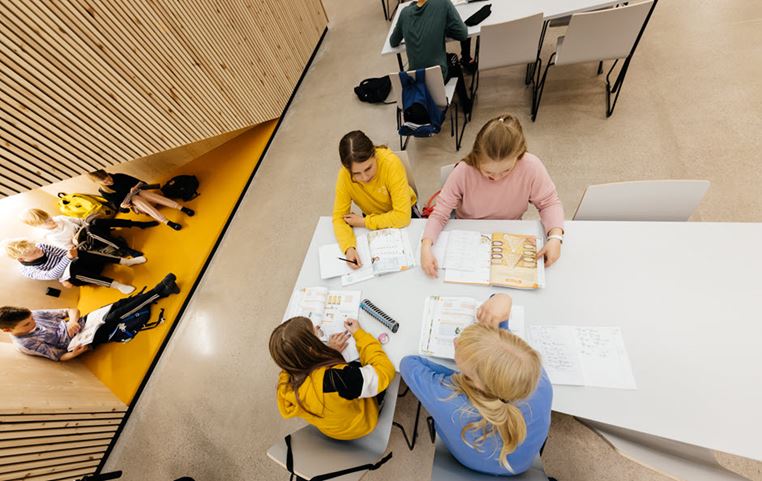Sustainable data centers as a service
- Work
- Construction
- Premises
- Life Cycle Project
- 3/20/2023
Life cycle projects are the key to responsible construction
The quality of maintenance in schools and day care centres completed with the life cycle model is high, and there are no surprise costs during the maintenance period. The project model is praised by both principals and the cities’ property managers.

In January 2022, schoolchildren in Lauritsala, Lappeenranta, moved from their old school that had indoor air problems to a grand new building.
“The new school has been a really big deal for the whole area,” says Principal Jukka Mielikäinen.
The new building has been designed for children and young people of all ages, from preschool onwards. Even after ninth grade, they can continue to spend their evenings and weekends in the youth facilities. The school building serves the older population, as well, as the school’s over 1,000 square metre ball-sports hall is in frequent use by sports clubs after lessons.
The first life cycle project in Lappeenranta
The new school is the first school building in the city of Lappeenranta to be completed with the life cycle model. In addition to being responsible for the design and construction, YIT will provide maintenance for the school for the next 20 years.
“We had a huge investment backlog with many schools to build. We wanted to try new kinds of procurement models in Lappeenranta,” Mielikäinen says.
The model selected for the Lauritsala school was the life cycle model, which guarantees a worry-free future for the modern school building.
Experiences during the first year have been extremely positive. Everyday school life runs smoothly, in accordance with the service agreement, as in any well-managed school property.
Everything has gone well. This is like an extended warranty. It brings peace of mind to the city’s management.
However, there are small differences. The cleaning and maintenance of the old school property was carried out by a limited company owned by the city, but nowadays, the Principal’s main partners are YIT’s Property Manager and Maintenance Manager. They are responsible for managing the maintenance of the property for the next 20 years, and they ensure that the facilities are in top shape and energy consumption remains low. The contract also covers, for example, porter services.
“In my opinion, the level of service has increased,” Mielikäinen estimates.
Flexible premises in Parkano
A similar modern school campus was completed in Parkano in August 2019. Sauli Noponen, Maintenance Manager at YIT, is responsible for the maintenance of the Parkano campus, which was built as a life cycle project. The 700-student campus hosts all grade levels; preschool, primary school, secondary school and upper secondary school, as well as an adult education centre that uses the same facilities. The technical administration of the multi-purpose property and the management of services take up approximately half of Noponen’s working time. At the moment, he is preparing plans for functional changes proposed by the users. The different alternatives are examined together on technical and economic grounds.

During the service period of 20 years, the spatial needs will change. This has been taken into account already in the design of the building. With the life cycle model, the changes can be smoothly implemented in practice.
“Changes can be implemented cost-effectively, as we have all the documentation and information at our disposal, starting at the construction stage.”
Feedback and experiences from the first years of the service contract make the maintenance manager happy.
“The client has given positive feedback on the easy maintenance of the school property. Real estate professionals take care of the maintenance, enabling the city to focus on its core task of teaching,” says Noponen.
The day-to-day matters of the Parkano school campus are planned at user meetings between Sauli Noponen, the campus principal and the city’s service coordinator. The project’s cooperation group meets four times a year to make the necessary decisions, involving representatives of the city management and the service providers.
“At the meetings, we look at the big picture and how well the contractual obligations have been fulfilled,” says Noponen.
A dozen life cycle schools in Espoo
The City of Espoo has extensive experience in life cycle construction. There are as many as 12 schools renovated with the life cycle model in Espoo.
For the city’s property management services team, the long maintenance contracts for the new school and day care centre properties mean carefree times in the near future.
“For the client, this is easy. All we need to do is to ensure that the maintenance is carried out in accordance with the agreement,” says Leif Ilander, Facility Services Manager at the City of Espoo.
Many municipalities have shunned life cycle projects for fear of the high cost of outsourced services and the difficulties with competitive tendering. Espoo had no cause for concern.
“Of course, we carried out a risk assessment at the procurement stage, but we could not identify any major risks,” Ilander says.
The latest school and day care centre project is a step further than traditional life cycle projects, as this project also includes financing for the construction investment. In the procurement model known as the Public Private Partnership Model (PPP), the City of Espoo signed a service agreement for the implementation of a total of eight school and day care centre properties with Partnership Schools Ltd, a joint project company of Meridiam and YIT. Partnership Schools is responsible not only for building the schools and day care centres, but also for financing, planning and maintaining them for a period of 20 years.
YIT is a partner and service provider in the project company. After the completion of each school or day care centre, the city starts to pay a service fee to the project company, which covers the financing, implementation and maintenance costs of the school or day care centre. Three of these schools and one day care centre opened in the summer of 2022.
There have not been any big concerns related to the life cycle model in Lappeenranta, either. Principal Jukka Mielikäinen says that there have been some questions on how the spaces can be used and, for example, whether it is appropriate to hang works of art by students on the brand new walls.
“These are trivial things that we have solved smoothly by discussing.”
Repair and maintenance costs under control
In many respects, the life cycle project is an attractive implementation method for municipal construction projects.
“Predictability of property maintenance costs, such as repair costs, plays a major role. In a life cycle project, this is on a whole new level,” Sauli Noponen says.
The long-term maintenance professional says that even well-built properties can include solutions that are not optimal from the point of view of maintenance. The long maintenance responsibility of life cycle projects obliges designers and builders to pay special attention to the usability and easy maintenance of the building.
When the construction of a new day care centre or school building becomes topical, attention typically turns to investment costs. However, when looking at the entire life cycle of a building, facilities management services, repairs and energy are even larger cost items, and these can be significantly reduced already at the design stage.
“When the building is constructed and maintained by the same organisation, the maintenance team is involved in the design phase and can influence, for example, structural decisions.”
The decades of experience of a large-scale construction company is valuable currency also in the maintenance phase of life cycle projects.
“YIT can predict pretty well what will happen in the property over the years. We are aware of the risks, but we keep them in control with good planning and maintenance,” Noponen says.
In Lappeenranta, the reason for choosing the life cycle model was the history of the old Lauritsala school. The school was renovated in 2008, but it turned out that the renovation was not enough to solve the indoor air issues.
The new school building that was implemented as a life cycle project is worry-free.
“This increases our sense of security. For the next 20 years, we can rest easy as long as we use the building with care,” says Principal Jukka Mielikäinen.
Energy efficiency in check
Sustainability is a key concern in all construction projects today. In this respect, life cycle projects are also faring well. For example, the new schools in Espoo will have geothermal heat systems that replace part of the purchased energy.
“However, these benefits are only gained when the building’s energy-efficient systems are used correctly and their operation is monitored throughout their life cycle,” Sauli Noponen points out.
This is the best advantage of the long maintenance period of life cycle projects in these times of expensive energy. The company bearing the maintenance responsibility manages the property as if it were its own.
“When we continuously monitor the conditions in the building, we get excellent insight for improving energy efficiency, for example.”
Under Noponen’s supervision, the Parkano school campus is subject to continuous small-scale adjustments.
“When people’s bodies heat the school premises during the day, we can reduce the amount of purchased energy during the day slightly. And we optimise ventilation operating times on the basis of indoor air monitoring.”

The most responsible way to use properties is to maintain them so that there will be no repair backlog. The best way to avoid repair backlog is through careful maintenance. In life cycle projects, even the contracts contain obligations on continuous monitoring.
“When we are responsible for maintaining the property, we constantly monitor wear and tear, the functioning of the systems and the prevailing conditions on a monthly basis,” says Noponen.
Read more:
Learning environments | School construction | YIT.fi
Kalliola school reaps the best benefits of life cycle construction | YIT.fi








